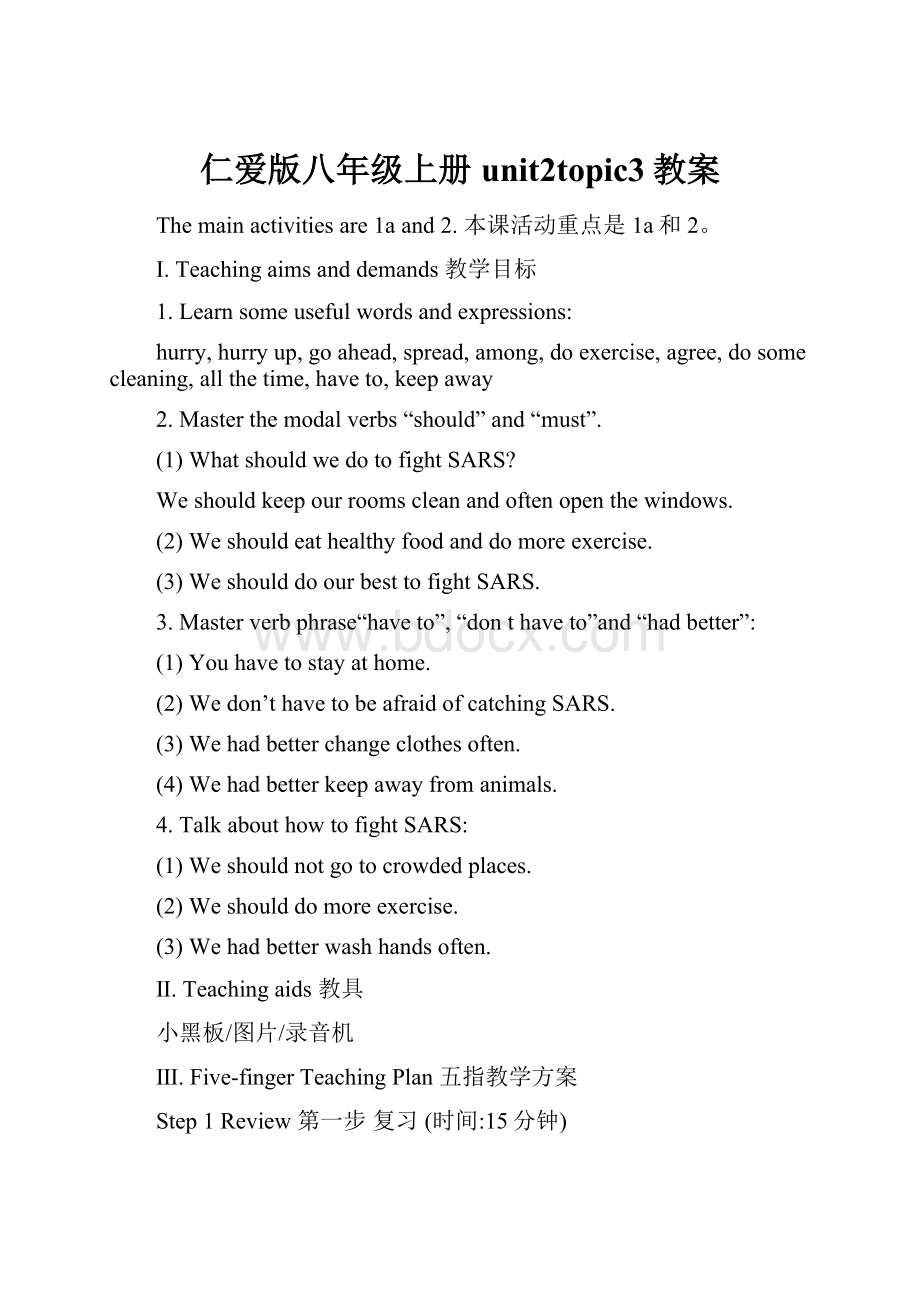 仁爱版八年级上册unit2topic3教案.docx
仁爱版八年级上册unit2topic3教案.docx
- 文档编号:17743814
- 上传时间:2023-04-24
- 格式:DOCX
- 页数:28
- 大小:29.85KB
仁爱版八年级上册unit2topic3教案.docx
《仁爱版八年级上册unit2topic3教案.docx》由会员分享,可在线阅读,更多相关《仁爱版八年级上册unit2topic3教案.docx(28页珍藏版)》请在冰豆网上搜索。

仁爱版八年级上册unit2topic3教案
Themainactivitiesare1aand2.本课活动重点是1a和2。
Ⅰ.Teachingaimsanddemands教学目标
1.Learnsomeusefulwordsandexpressions:
hurry,hurryup,goahead,spread,among,doexercise,agree,dosomecleaning,allthetime,haveto,keepaway
2.Masterthemodalverbs“should”and“must”.
(1)WhatshouldwedotofightSARS?
Weshouldkeepourroomscleanandoftenopenthewindows.
(2)Weshouldeathealthyfoodanddomoreexercise.
(3)WeshoulddoourbesttofightSARS.
3.Masterverbphrase“haveto”,“donthaveto”and“hadbetter”:
(1)Youhavetostayathome.
(2)Wedon’thavetobeafraidofcatchingSARS.
(3)Wehadbetterchangeclothesoften.
(4)Wehadbetterkeepawayfromanimals.
4.TalkabouthowtofightSARS:
(1)Weshouldnotgotocrowdedplaces.
(2)Weshoulddomoreexercise.
(3)Wehadbetterwashhandsoften.
Ⅱ.Teachingaids教具
小黑板/图片/录音机
Ⅲ.Five-fingerTeachingPlan五指教学方案
Step1Review第一步复习(时间:
15分钟)
1.(引入竞争机制,复习前面Topic的单词、词组,采用单词竞赛,分为必答、抢答。
)
T:
Nowlet’shaveawordcompetition.Eachstudenthastwowords.I’llgiveyouChinesemeaning,pleasereadtheminEnglish.Areyouready?
Go!
...
T:
Welldone!
Thistimelet’shaveaquickanswer.Whoknows?
Youcanstandupandanswerquickly!
Begin!
2.(教师让学生陈述良好的生活习惯与一些不良生活习惯的话题,引导学生使用句型:
)
Weshoulddo...
Weshouldn’tdo...
Wemustdo...
Wemustnotdo...
Wedon’thaveto...
T:
Let’sreviewwhataregoodhabitsandwhatarebadhabits.Usethesesentences:
Weshoulddo...
Weshouldn’tdo...
Wemustdo...
Wemustnotdo...
Wedon’thaveto[WW()...
3.(教师提问,请学生回想前面讨论的关于健康话题。
)
T:
Whatshouldwedotokeephealthy?
(在学生回答之前,教师先给出一个答语,引出本课目标语言haveto,don’thaveto。
)
Whatshouldwedotokeephealthy?
T:
(教板书目标语言,并强调haveto的用法。
)
Andwedon’thavetoeatmoremeat.
T:
(要求学生使用目标语言haveto,don’thaveto来回答问题。
)
S1:
Wehavetokeepwindowsopenintheday.
S2:
Wedon’thavetokeepwindowsopenallthetime.
S3:
Wehavetosweepthefloorsoften.
S4:
Wedon’thavetotakemedicineoften.
...
(以同样的方法,教师提问,在学生回答之前,教师先给出一个答语,引出本课目标语言hadbetter。
)
T:
Whatelseshouldwedotokeephealthy?
Wehadbetterdrinkeightcupsofwatereveryday.
T:
(教师板书目标语言,并强调hadbetter的用法。
然后要求学生使用目标语言hadbetter继续回答所提问题。
)
S5:
Youhadbettergotobedbeforenineo’clockintheevening.
S6:
Shehadbettergotoschoolbybike.
S7:
Wehadbetterkeepourfingernailsclean.
...
(老师对积极回答问题的学生要及时给予表扬。
)
4.(教师由谈论如何保持健康来引出SARS话题。
)
T:
Goodhabitscanhelpustokeephealthy.Butbadhabitscancausediseases.In2003,therewasaseriousdiseasecalledSARS.
WhatdoyouknowaboutSARS?
(让学生讨论几分钟,也可让他们快速查阅资料来寻找答案。
)
Forexample:
SARSisshortforSevereAcuteRespiratorySyndrome.
(几分钟后,开始有学生举手,此时教师对表达有困难的学生要及时给予帮助。
)
S8:
Itspreadseasilyamongpeople.
S9:
SARSisaseriousdisease,butwedon’thavetobeafraidofcatchingSARS.
...
5.(教师提问关于Kangkang父亲的一些情况,导入下一步。
)
T:
What’sKangkang’sfather?
Ss:
Heisadoctor.
T:
Yes,heisadoctor.HeknowssomethingaboutSARSandheknowshowtofightit.Now,let’slisten.
Step2Presentation第二步呈现(时间:
5分钟)
1.(设置并出示小黑板上的听力任务,让学生带着任务听录音。
)
(1)WhereisKangkang’sfather?
(2)WhatdoyouknowaboutSARSaccordingtothetape?
(3)WhatshouldwedotofightSARS?
(听录音,回答上面问题。
)
T:
Now,listentothetapeandfindouttheanswerstothesequestions.
(请几个同学回答问题,或分组讨论形成共识。
)
Answers:
(1)HeisonTV.
(2)SARSspreadseasilyamongpeople.
(3)Weshouldeathealthyfoodanddomoreexercise.Weshouldnotgotocrowdedplaces.
2.(打开课本,请学生跟读课本1a的对话。
)
T:
Openyourbooks,andreadthedialogafterthetape.
3.(师生共同查找1a中的关键词并板书在黑板上。
)
T:
Letsfindoutthekeywordsandwritethemdownontheblackboard.
onTV—asksomequestions—SARS—spread—among—healthyfood—moreexercise—not
gotocrowdedplaces
Step3Consolidation第三步巩固(时间:
5分钟)
1.(再放一遍录音,请学生跟读并模仿对话。
)
T:
Listentothetapeagain,followthetapeandimitate.
2.(学生读1a的对话,然后两人一组练习。
)
T:
Readthedialogin1a,thenpracticethedialoginpairs.
3.(找几组同学来表演这个对话。
)
T:
Now,I’dlikesomepairsofstudentstoreadandactoutthedialog.
4.(要求学生合上书,只看黑板上的关键词,两人一组表演对话。
)
T:
Closeyourbooks.Lookatthekeywordsontheblackboard,thenactoutthedialoginpairs.
(教师此时不应该强调学生按原文表演,可适当发挥。
)
5.(做1b。
学生先听录音,然后两人一组完成,然后每组选一名代表向全班汇报。
)
T:
WhatshouldwedotofightSARS?
Listentothetapeof1b,check(√)thecorrectboxes.Afterlistening,youcanworkinpairs.Iwillchoosesomestudentstogiveareporttotheclass.
(再放一遍听力,学生互相核对答案。
)
T:
Listentothetapeagainandchecktheanswersinpairs.
Step4Practice第四步练习(时间:
10分钟)
1.(教师呈现两个对话,先让学生读,然后再两人一组表演对话。
)
T:
Lookatthetwodialogs.Firstreadthedialogs,thenpracticeinpairs.
ExampleA
S1:
WhatshouldwedotofightSARS?
S2:
Wemusteathealthyfood.
S1:
OK.Thankyou.
ExampleB
S3:
WhatshouldwedotofightSARS?
S4:
Wemustopenthewindows.
S3:
Mustwekeepthewindowsopenallthetime?
S4:
No,wedon’thaveto/needn’t.
(教师应着重强调两个对话中本课目标语言should,must,don’thaveto的用法。
)
2.(要求学生参照这两个对话来写相似的对话,要求两人一组,还可以参考1b里的信息。
)
T:
Followtheexamplestomakesimilardialogs,workinpairs,usingtheinformationin1b.
3.(教师要求几组学生表演他们的对话。
)
T:
NowI’dlikesomepairstoacttheirdialogsout.
4.(要求学生看2的图片,然后根据图片讨论怎样预防SARS。
)
T:
Lookatthepicturesin2.DiscusswhatshouldwedotofightSARS.
(学生讨论几分钟后,要求学生完成2里面的练习,强调学生注意should,hadbetter,must的用法。
)
T:
Lookatthepictures,doexercisesin2.
(学生完成之后,要求学生模仿前面出现的对话两人一组练习对话,对话中必须使用本课目标语言Weshould.../Wehadbetter.../Wemust...)
T:
Followtheexamplestomakedialogs,usingthesentences“Weshould.../Wehadbetter.../Wemust...”
Forexample:
Dialog1:
S5:
WhatshouldwedotofightSARS?
S6:
Weshoulddomoreexercise.
Dialog2:
S7:
WhatshouldwedotofightSARS?
S8:
Wehadbetterwashhandsoften.
Dialog3:
S9:
WhatshouldwedotofightSARS?
S10:
Wemustkeepawayfromanimals.
(学生小组练习之后,教师可以请几组到讲台前为大家表演他们的对话。
)
Step5Project第五步综合探究活动(时间:
10分钟)
1.(把班里的学生分成两大组,每组分别在黑板上写出如何预防SARS,强调要使用本课目标语言,比一比,哪组写得最好最完整。
)
T:
Let’sdividetheclassintotwogroups(AandB).EachgroupwritesdownhowtofightSARSontheblackboard.Thegroupthatwritesmoreandbetteristhewinner.
2.(四人一组做一个采访。
一人扮演记者,其他三人扮演医生,回答记者的提问。
要求学生学会以采访的形式与他人对话。
)
T:
Makeaninterview,fourinonegroup.Supposeoneisajournalistandtheothersaredoctors.Heasksquestions,theotherthreeanswer.
3.Homework:
每个学生至少写五句话来说明如何预防SARS。
SectionB
Themainactivitiesare1aand3.本课重点活动是1a和3。
Ⅰ.Teachingaimsanddemands教学目标
1.Learnsomeusefulwordsandexpressions:
justamoment,examine,patient,getthrough,care,takecareof
2.Learnsomeexpressionsonmakingatelephonecall:
(1)—Hello!
Extension6226,please.
—Justamoment,please.
(2)—CouldIspeaktoYuping?
—Sorry,heisn’thererightnow.
(3)—I’mafraidhe’sbusyrightnow.
—I’llringhimuplater.
(4)CanIleaveamessage?
(5)ThisisKangkangspeaking.
(6)I’llgiveherthemessage.
(7)Couldyoupleaseaskhertocallmeback?
(8)—IsZhuMingthere,please?
—No,heisn’tin.
3.Learnhowtotakeandreadamessageofatelephonecall.
Ⅱ.Teachingaids教具
小黑板/录音机/卡片/挂图或多媒体课件
Ⅲ.Five-fingerTeachingPlan五指教学方案
Step1Review第一步复习(时间:
15分钟)
1.(让学生四人一组表演上节课布置的采访活动,一人扮演记者,其他三人扮演医生,回答记者的提问。
)
T:
Makeaninterview,fourinonegroup.Oneisajournalist,theothersaredoctors.Whichgroupwantstohaveatry?
OK,yourgroup,please.
S1:
Hi,doctors,mayIaskyousomequestions?
S2,S3andS4:
Sure.
S1:
WhatshouldwedotofightSARS?
S2:
Wedon’thavetobeafraidofcatchingSARS.
S3:
Weshouldeathealthyfoodanddomoreexercise.
S4:
Weshouldnotgotocrowdedplaces.
...
(教师可以选三个小组表演,并评选出最佳小组。
)
2.(请学生简单复述如何预防SARS以及如何与SARS做斗争,至少说出三句。
)
T:
EveryoneretellsatleastthreesentencesabouthowtofightSARS.
Ss:
...
3.(教师呈现三个有关打电话的对话,先让学生读对话。
)
T:
Therearethreedialogs.Nowreadbyyourselves.
(教师在黑板上板书三个对话,或用多媒体展示。
)
Dialog1:
S5:
MayIspeaktoLiLei,please?
S6:
I’msorry,heisn’tin.Who’sthatspeaking?
S5:
ThisisAnn.I’llhaveabirthdaypartyonSaturdayevening.
S6:
Really?
Wherewillitbe?
S5:
Inmyhouse.
S6:
Whenwillitstart?
S5:
At7∶00.
S6:
OK.I’llgiveherthemessage.
S5:
Thankyou.
Dialog2:
S7:
IsLucythere,please?
S8:
No,sheisn’tin.CanItakeamessage?
S7:
Yes,please.ThisisJim.CouldIplaybasketballwithherthisafternoon?
S8:
Whenandwherewillyoumeet?
S7:
At2o’clockattheschoolgate.
S8:
OK,I’llgiveherthemessage.
Dialog3:
S9:
CouldIspeaktoKangkang,please?
S10:
I’msorry,heisn’thererightnow.Doyouwanttoleaveamessage?
S9:
Yeah.ThisisBetty.Ourclasswillhaveapartyat7:
00.onSaturday.
PleasetellhimtobringhisCDs.
S10:
OK,I’llgivehimthemessage.
(教师要求学生两人一组,练习对话,然后让几组到台前表演。
)
T:
Practicethedialogsinpairs.I’llasksomepairstoactthemoutinfrontoftheclass.
(在学生操练完以后,师生共同寻找打电话的交际用语。
)
4.(要求学生给每一个对话写一个电话留言,教师可以先给一个示范并板书。
)
T:
I’dlikeyoutowritethetelephonemessagesaccordingtothedialogs.
Forexample:
Message:
LiLei,
Anncalled.
Shewillhaveabirthdaypartyat7∶00onSaturdayeveninginherhouse.
(教师示范以后,要求学生根据示范写出其他两个电话留言,对有困难的学生要及时提供帮助,学生完成以后,小组先交换检查,然后评选最佳的同学读给全班听。
)
T:
Areyouready?
Nowexchangeyourmessageswithyourpartner.I’llasksomestudentstoreadtheirmessages.
5.(教师呈现两个电话留言,要求学生两人一组,根据电话留言编两个对话。
)
T:
Therearetwotelephonemessages.Canyoumaketwodialogsaccordingtothemessages?
Message1:
Tony,
Jenniecalled.
Areyougoingtoseeafilmwithherthisevening?
Callherback.
Message2:
Bruce,
Kangkangcalled.
CanheborrowyourcamerathisSaturday?
Hewillhaveatrip.
Ifyes,whencanhegetit?
(学生编完对话以后,先两人一组操练所编对话。
然后教师让几组同学上台表演他们所编的对话。
)
T:
Nowpracticethedialogsinpairs.I’dlikesomepairstoactouttheirdialogs.
6.(教师提问关于Kangkang父亲的一些情况。
)
T:
What’sKangkang’sfather?
Whe
- 配套讲稿:
如PPT文件的首页显示word图标,表示该PPT已包含配套word讲稿。双击word图标可打开word文档。
- 特殊限制:
部分文档作品中含有的国旗、国徽等图片,仅作为作品整体效果示例展示,禁止商用。设计者仅对作品中独创性部分享有著作权。
- 关 键 词:
- 仁爱 年级 上册 unit2topic3 教案
 冰豆网所有资源均是用户自行上传分享,仅供网友学习交流,未经上传用户书面授权,请勿作他用。
冰豆网所有资源均是用户自行上传分享,仅供网友学习交流,未经上传用户书面授权,请勿作他用。


 #全自动电容电感测试仪.docx
#全自动电容电感测试仪.docx
